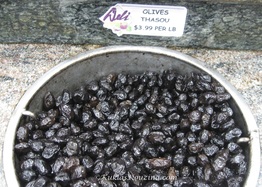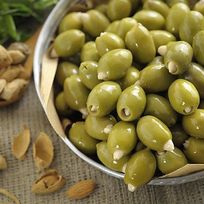Beyond Kalamata

“…the fruit of the olive tree is a great boon
for everything needed in life…”
(Solon, Athenian lawgiver, 640-560 BC)

"Care for me and I will nourish you.
Water me and I will make you rich"
(Greek proverb)


An exclusive olive variety can be found in just about every region of Greece, with some varieties named after the region they’re grown in. Greece is the world’s third largest producer (behind Spain and Italy) of olives and olive oil so you know Greeks are serious when it comes to their olives—they consume more olive oil than any other European country (about 26 liters per person annually).

Which variety will you love? Since variety is the spice of life, why not enjoy them all?!
Kouloumbotes
(dry-cured, black, small)
These black crinkly gems from Karpathos are related to the Thrubolea variety and are an island delight. They’re tree ripened and hand picked, making them especially fruity and sweet, as well as tender. After curing, they’re lightly coated with extra-virgin olive oil, resulting in a perfect food (they’re made into delicious olive oil too!). Kouloumbotes can be found growing in most Karpathian villagers’ backyards (including ours) and are served at every taverna on the island.

(dry-cured, black, small to medium)
The wrinkled black Thrubolea (throumpa/throuba) olive comes from the island of Thasos/Thassos in the northern part of the Aegean Sea and is a bit larger than the famed Moroccan, with a smaller pit making this variety meatier. Thasou olives are ripened on the tree so they loose their bitterness before they’re picked. Once dry-cured, they are lightly coated with extra-virgin olive oil and mildly seasoned with sea salt. They’re intensely fruity and nutty in flavor. To serve, drizzle with extra-virgin olive oil and sprinkle with fresh oregano.

(brine-cured, green, jumbo, oval)
This is a meaty, smooth-skinned, medium-green olive that comes from the Conservolia tree in Agrinio near Greece’s west coast by the Ionian Sea. The Agriniou olive’s firm, juicy flesh is effortlessly removed from the pit, making them easy to eat or use in recipes. Once brined, the fruity olives are lightly coated with extra-virgin olive oil, and tossed with oregano, lemon slices, and garlic cloves. They also come with a coating of hot red-pepper flakes. Talk about savory and satisfying!

(brine-cured, green, large or jumbo, oval)
Tree ripened, these light- to medium-green, smooth-skinned, plump olives can be found in two varieties, the Conservolia, grown in the hills of Amfissa near the ancient city of Delphi (home of the Oracle of Delphi), or more often the larger, lighter green Halkidiki/Chalkidiki from the region of the same name in northern Greece. They’re picked when very large in size (to accommodate the stuffing), then slowly brined, producing a fruity and mild olive with a crisp skin and meaty flesh. The pits are replaced with whole blanched almonds for an irresistible spin on the plain olive…or plain almond for that matter!

(brine-cured, green, small to medium, almond-shaped)
These light-green olives are of the Megaritiki variety and grow in the valley of Argos near Nafplion on the eastern coast of the Peloponnesian Peninsula. They have a crisp, firm texture, and a faintly smoky, nutty flavor. Nafplio olives are available plain, spiced with coriander seeds, or coated with extra-virgin olive oil, and herbs, with slices of fresh lemon.

(brine-cured, purple, medium, large, jumbo, almond-shaped)
This famous light- to deep-purple olive comes from the Kalamon tree grown in the Kalamata region on the southwestern side of the Peloponnesian Peninsula.
These olives are protected under the EU so they must be from this area and harvested from these trees to be called “kalamata,” so beware of labels like “kalamata-style” or “kalamata-type” as they will not be the real deal. Authentic kalamata olives can also be labeled “PDO Kalamata,” which refers to the olive's Protected Designation of Origin (the PDO label is used on other Greek olive varieties as well).
Kalamata olives are smooth, tight-skinned and meaty, and are imparted with a richly unique fruit-wine flavor from the addition of red wine or red-wine vinegar to the brine during the curing process. This olive comes in a variety of sizes, though the medium and large can be firmer than the jumbo. As for the shade, the deeper the color, the riper the fruit. These olives also come pitted for easy serving in salads, baking in breads, or pureeing for olive spread.

(from kalamata olives)
This is a deep-purple tapenade made purely from kalamata olives. Flavored with a dash of lemon juice and oregano makes it ideal for spreading on crackers or bread as a meze, or for use as a topping on fish and vegetables. Our favorite brands are Iliada and Castella—they have the perfect balance of flavors and texture.

The following in-store and online options will have you saying “Ναί!"
If you’re in the New York City area you can find these Greek olives (and more) at the following markets (they do phone orders and ship as well):
Titan Foods
25-56 31st Street
LIC, N.Y, 11102
718-626-7771
Mediterranean Foods (2 locations)
22-78 35th Street
Astoria, NY 11105
718-721-0266
30-12 34th Street
Astoria, NY 11103
718-728-6166
Sahadi’s
187 Atlantic Avenue
Brooklyn, NY 11201
If you don’t live near these markets but have a Greek Orthodox Church nearby, chances are they know of a Greek/Mediterranean shop in the area.
Online shopping is the next best thing but you won’t find the selection that’s available in-store. Here’s where you can find Greek olives, as well as other foods and items:
Titan Foods
Sahadi’s
Recipiada
Greek Internet Market
Amazon
igourmet.com
If you can’t get enough of Greek olive culture, check out my blogs Olive Oil Odyssey and Olive Oil~Branch to Bottle (a behind-the-scenes look at our favorite olive-oil producer, Mentis Estate).
I hope you enjoyed Olive Kouzina. Some of these olives will be featured in recipes in our upcoming cookbook. Stay tuned for more uniquely Greek and Karpathian foods that you can add to your kouzina pantry.
Sign up for our e-newsletter (if you haven’t already) and stay connected on social media for cooking tips and recipes, as well as for all Kukla's Kouzina updates and news.
Thanks for following us and we’ll see you next Monday!
Until then~
Kali orexi! Good appetite!
Kelly
Sources
The Dr. Oz Show~Mediterranean Superfood: Olives
International Olive Oil Council
USDA
Kalamata Olives: One of the Healthiest Foods on Earth | Nutrition Advance
worldatlas.com
Parthenon: Olive fruit
Web design by Kelly Salonica Staikopoulos








